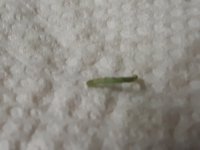CatPharm
Rising Star
Hi all,
Very haapi to get to post in this section. My first true love and introduction to plant medicines and though i dont indulge these days, im very gratful that i now get to learn from her through cultivation.
So for this pest situation im curious to find a spray, if needed, that wont be harmul to newly forming flowers.
I found this little guy loungin on a leaf this morning, but didnt have time to really give a thorough inspection. Sorry for the horrible photo, this thing didnt wanna cooperate first thing in the morning, but as far as i know it may be the only one to be hangin around.
There may be no pest problem whatoever. To be honest, id rather not have to spray or kill any little bug or worm i might find. As long as theres no damage being done, then its for all to enjoy.
If needed tho, is there a safest choice for a flowering plant?? Is there anything out there i can use in the future to deter rather than exterminate??
Thanks for reading and any suggestions. Peace
Very haapi to get to post in this section. My first true love and introduction to plant medicines and though i dont indulge these days, im very gratful that i now get to learn from her through cultivation.
So for this pest situation im curious to find a spray, if needed, that wont be harmul to newly forming flowers.
I found this little guy loungin on a leaf this morning, but didnt have time to really give a thorough inspection. Sorry for the horrible photo, this thing didnt wanna cooperate first thing in the morning, but as far as i know it may be the only one to be hangin around.
There may be no pest problem whatoever. To be honest, id rather not have to spray or kill any little bug or worm i might find. As long as theres no damage being done, then its for all to enjoy.
If needed tho, is there a safest choice for a flowering plant?? Is there anything out there i can use in the future to deter rather than exterminate??
Thanks for reading and any suggestions. Peace






